Tom's Guide Verdict
Boasting a large display, accurate activity, sleep and heart rate tracking, and smartphone notifications, the Garmin vivosmart HR is the fitness tracker to beat.
Pros
- +
Large display
- +
Accurate step-tracking and heart-rate monitoring
- +
New daily goals feature
- +
Easy setup
- +
Waterproof design
Cons
- -
Screen overly sensitive
- -
Shorter battery life than competition
- -
No built-in diet tracking
Why you can trust Tom's Guide
Geared toward those looking to get more out of their workouts, the vivosmart HR ($149) incorporates a heart rate monitor and a large LCD to keep tabs on everything from your distance and calories burned to floors climbed and "intensity minutes." This tracker also lets you view the weather and notifications from your smartphone, and control music playback, although this gadget is not trying to be a smartwatch. If you're looking for a fitness tracker with a little extra, the vivosmart HR is the one to get.
Design
Due to its large display, the Garmin vivosmart HR is bulkier than its main competitor, the Fitbit Charge HR. Still, both are roughly the same width — 0.83 inches — and the vivosmart HR is slim enough (0.48 inches) that it didn't get caught on the sleeve of my coat or sweater, which is more than I can say for some watches I've worn. It's also small enough that you won't notice it when you're sleeping.
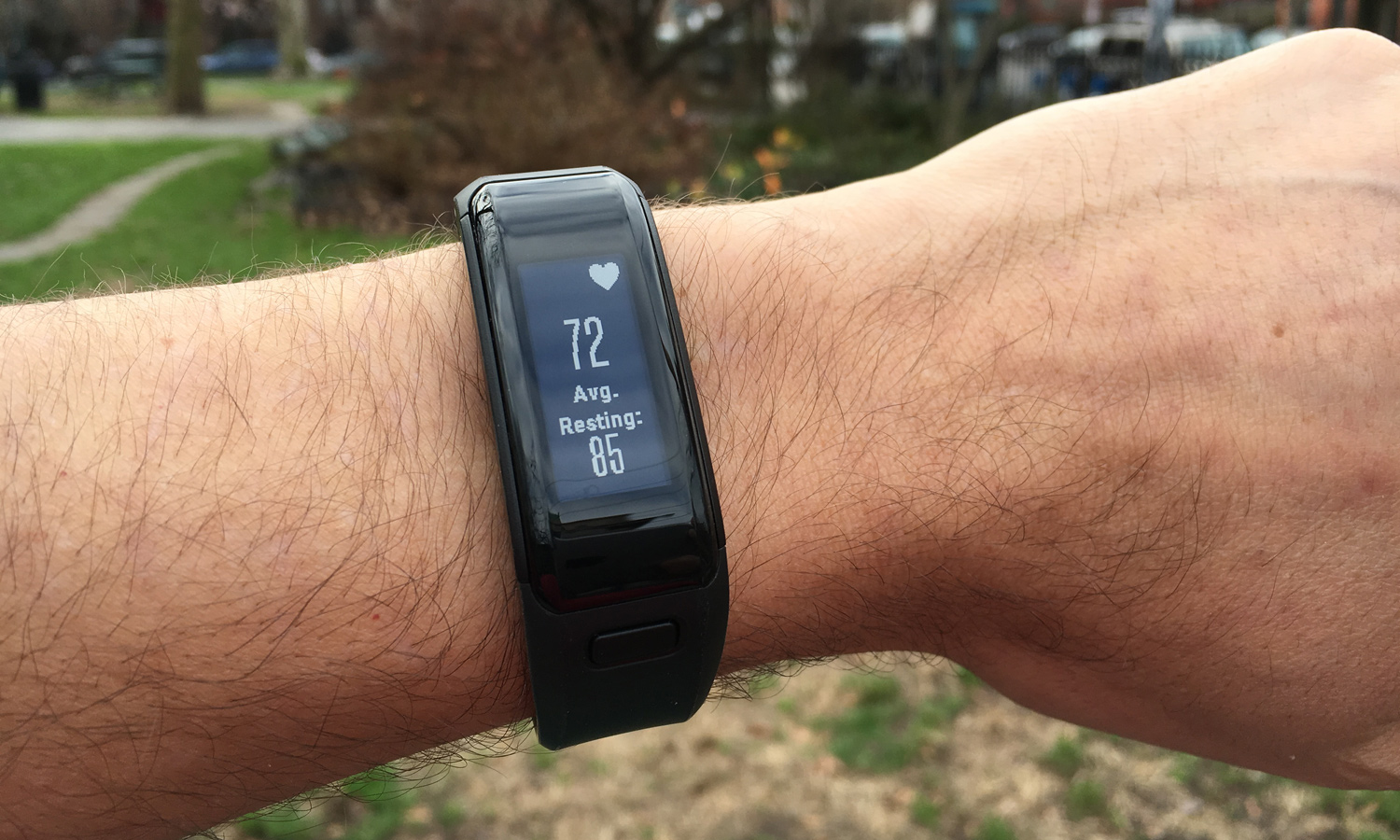
The vivosmart HR band uses a watchband clasp. The notches are close together, which means the device should fit snugly on wrists of all sizes. (As someone with skinny wrists, I appreciate this.) Garmin also sells the device in two sizes, Regular and Extra Large.
The heart rate monitor does leave an imprint on your wrist if you wear the device tightly, which is how Garmin recommends you wear the tracker if you are exercising. That said, it didn't bother me while I was wearing it, as the monitor itself seems to be designed to rest between the radius and ulna of the wrist.
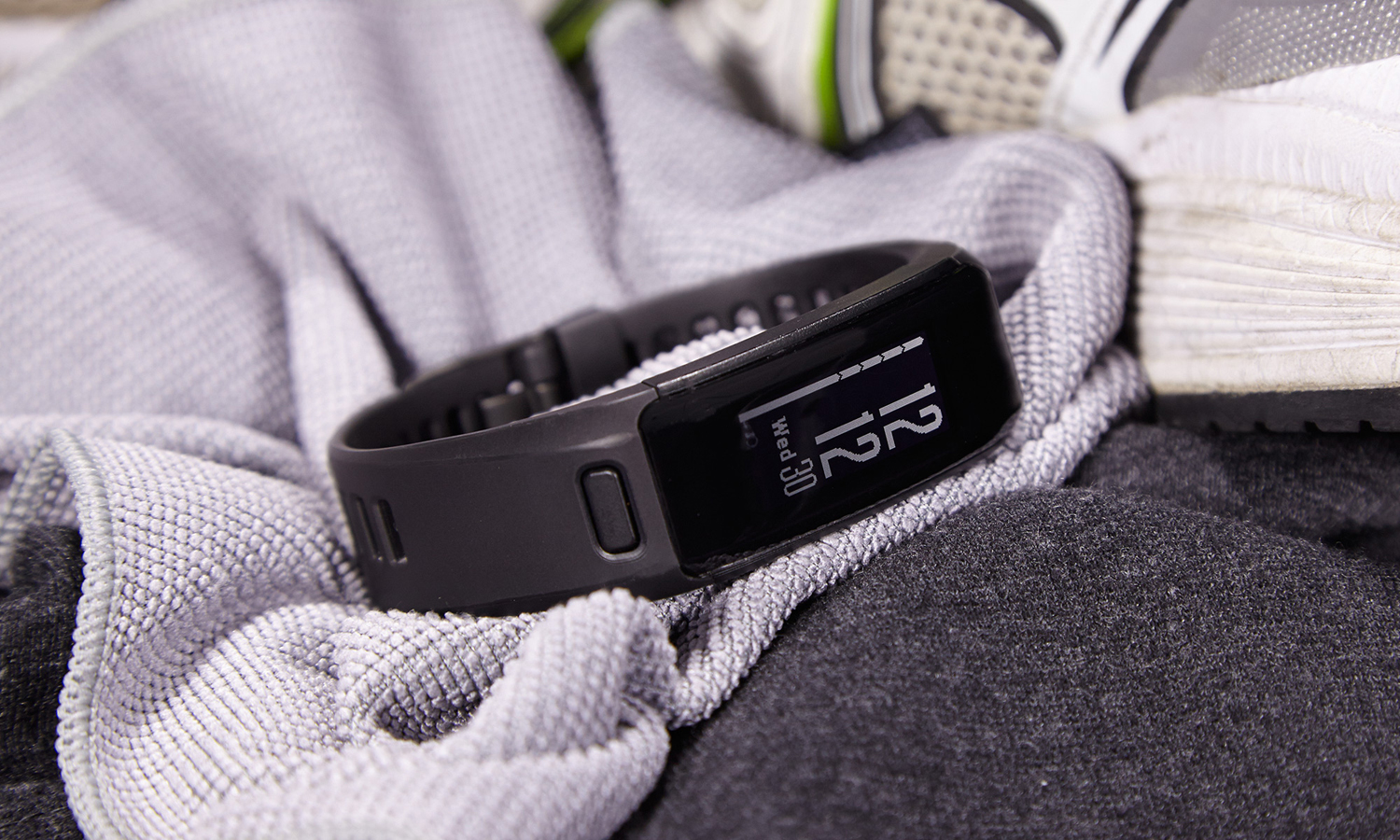
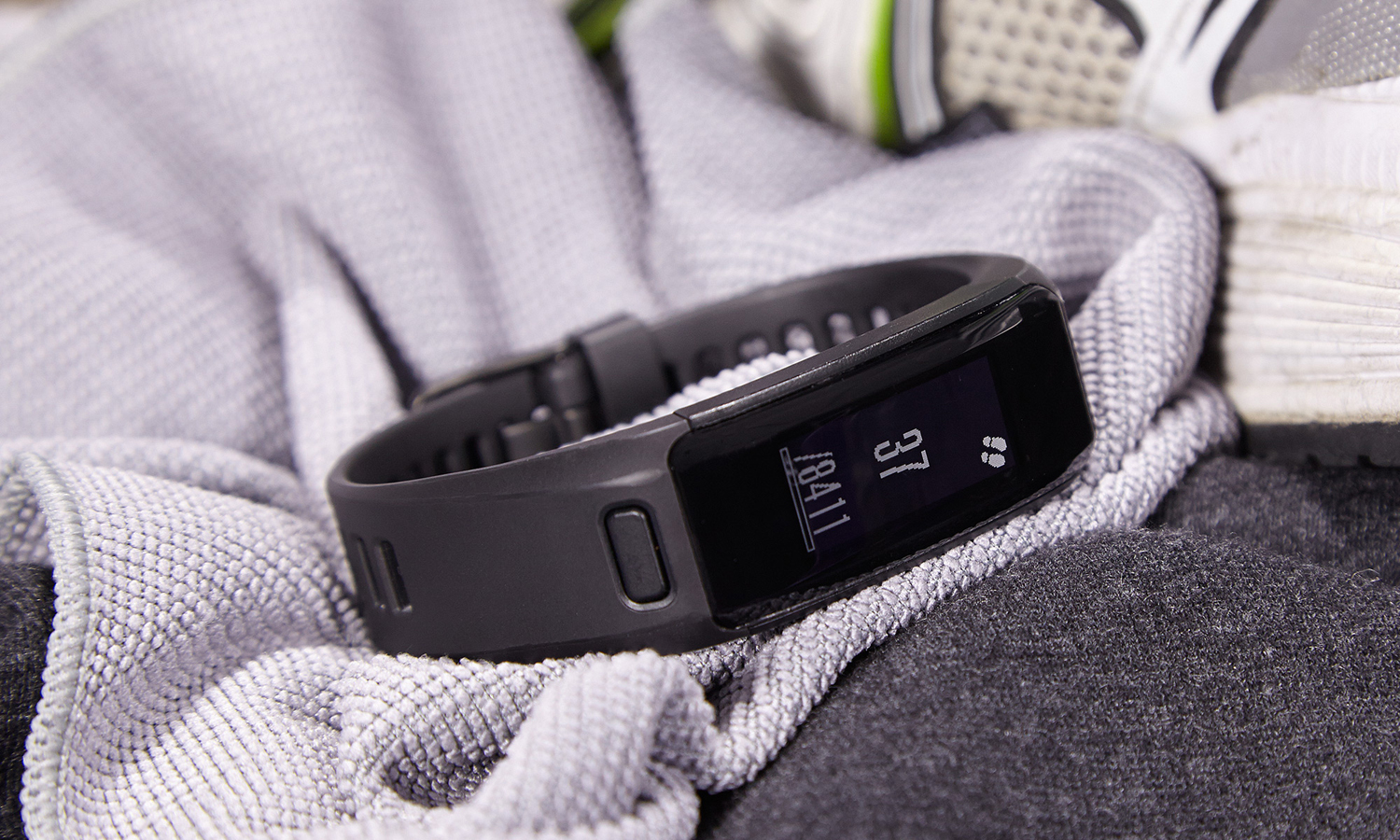
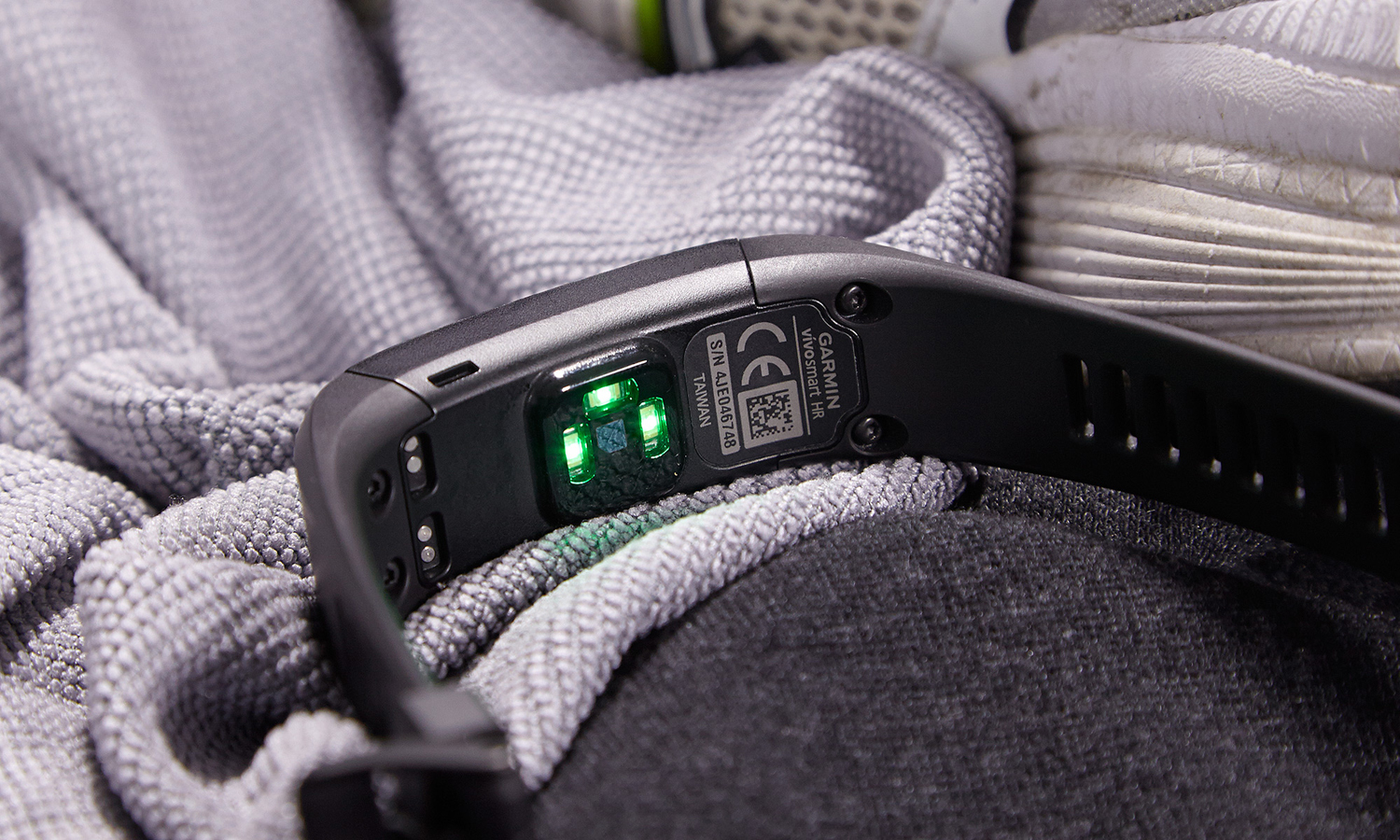

Waterproof to 165 feet, the vivosmart can withstand the elements much better than can the Charge HR, which is merely splash-proof.
Display
The vivosmart HR comes with a 1 x 0.42-inch, 160 x 68-pixel display. That's a lot larger than the small OLED screen on the Charge HR, which is capable of showing just one line of text. Garmin's default screen includes the time, day and date, along with the Move bar. (More on that later.) Tapping the device provides several seconds of backlighting. I also like that you can orient the text to run either horizontally or vertically on the screen.
Swiping from right to left across the device lets you switch among 10 screens to view stats such as steps, stairs climbed, active minutes, heart rate, notifications and weather.

Each screen also has a small icon — a heart for heart rate, a flight of stairs for floor climbed and so on — that's visible at a quick glance. You can manage the order of the screens, as well as select any you don't want to see, using Garmin Connect.
The swiping feature is quite sensitive. This means you can swipe while wearing winter gloves, which is a nice bonus for anyone accustomed to pulling off a glove to use a smartphone. But the sensitivity does have drawbacks. Unintentionally rubbing the vivosmart HR screen can cause it to scroll, though after a few seconds the device does revert back to the home screen.
On more than one occasion, I managed to start playing music on my phone when I actually meant to swipe past the music control screen. (You can disable music player connections using Garmin Connect. I learned my lesson the second time I made the mistake.)
MORE: Best Fitness Trackers for Running, Swimming and Training
App
After creating your account, Garmin Connect will start setting step goals for you. The default is 7,500, but this will change daily based on your activity level, hence the latest Garmin marketing slogan, "Beat yesterday." After a few days of wearing the vivosmart HR, my daily goal hit 8,909 steps. When I missed that goal — I was resting my legs after running my first 5K since tearing my calf in October — the next day's goal came in at 8,884.
The vivosmart HR syncs to the phone app via Bluetooth. On the phone, you can swipe among "snapshots" that provide a summary of your day, steps, sleep, intensity minutes and weight. Garmin describes moderate-intensity workouts as those during which you can have a conversation, and vigorous workouts as those during which you can only manage a few words between breaths.
You can organize snapshots directly from your phone and add snapshots from the browser-based version of the app. However, unlike with Fitbit's app, you can't input food data directly; you'll have to use a second app, such as MapMyFitness.
You can also sync the vivosmart HR to your computer with an included USB cord. (This also charges the device.)
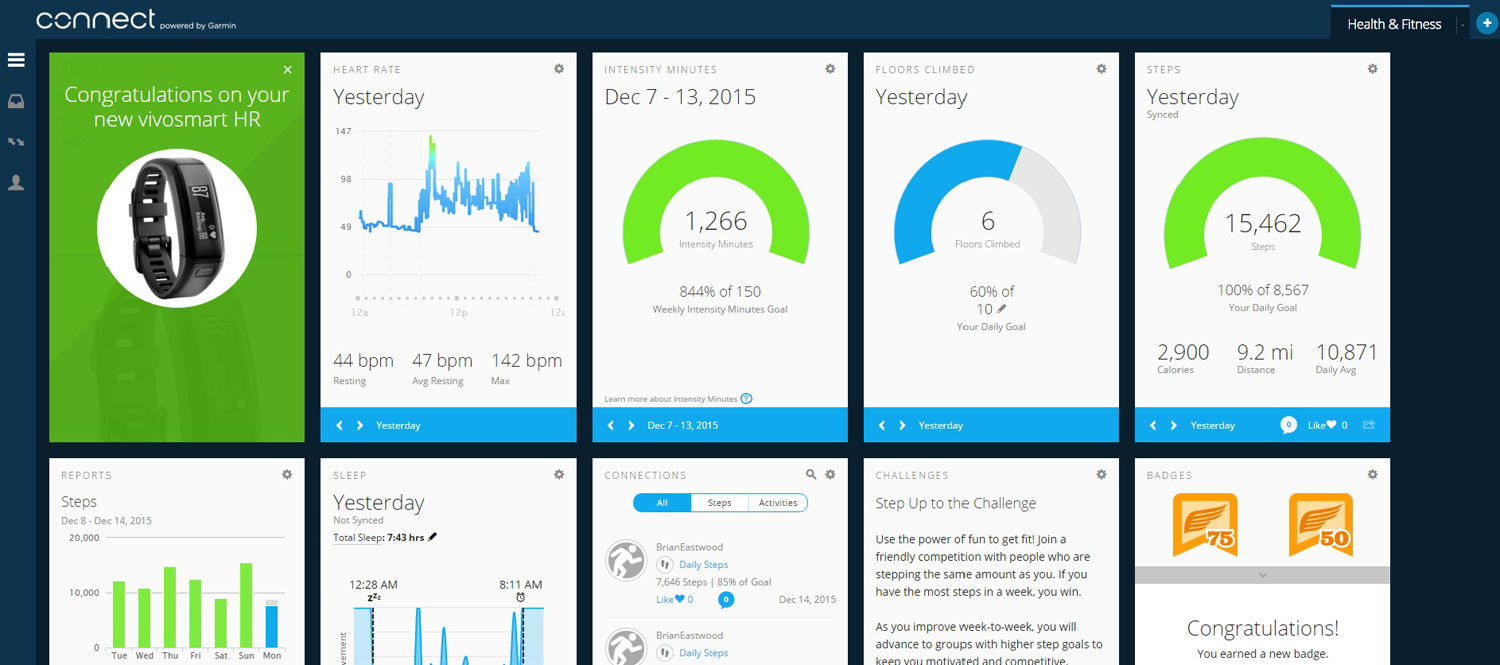
Garmin Connect's Web interface lets you view all your data without having to switch among multiple screens; for example, you can view heart rate data, see the badges you've earned and receive updates from your connections. You can see this data in the mobile app, but you have to search the menu to find it.
Notifications
The vivosmart HR provides three main types of notifications. When you hit your steps or flights of stairs goal, the device vibrates several times, the display reads GOAL and you see a small fireworks display.
When you have been inactive for more than an hour — which is indicated on the Move bar on the main time display — the device vibrates twice and reads MOVE! When that happens, it's time to get up and, well, move. (Luckily, my workday vibrations coincided with my trips to the kitchen for a coffee refill.)
The vivosmart HR step counter is surprisingly accurate for a tracker that isn't GPS-enabled.
If you have opted in to receive smartphone notifications on your vivosmart HR, the device vibrates once if you receive a notification. Tap on the device to read the message or dismiss it, or just wait a few seconds for the device to return to the time screen.
The fitness notifications are helpful, but the phone notifications are a mixed bag. They're nice for incoming phone calls, text messages, Facebook and Twitter updates, and the occasional important email — the vivosmart HR can display three lines of text. But feeling a vibration for every social media notification gets old fast, especially if you also see those notifications on your phone and your computer. If you're an active social media user, I recommend shutting off those notifications and sticking to phone calls and text messages.
Accuracy
The vivosmart HR step counter is surprisingly accurate for a pedometer that isn't GPS-enabled. When I took a walk to and from the post office, this device counted 400 steps first as 401 and then as 399 steps. I tried again the next morning, and a 300-step walk back from the coffee shop registered as 295 steps.

As with other activity trackers I've worn, though, the vivosmart HR counts more than just steps taken as "steps." During my time wearing the device, tasks such as doing the dishes, brushing my teeth, showering and stirring a pot of fried rice all registered as steps.
I took the vivosmart HR and a Polar chest-strap heart rate monitor on a 25-minute run. The Polar recorded a maximum rate of 180 BPM, compared to 171 BPM on the vivosmart HR.
In a head-to-head test against the Fitbit Charge HR, and using the Polar H7 heart rate strap and an iPhone 6s connected to MapMyRun as a control, the Garmin and the Fitbit were equally accurate when measuring heart rate. But the vivosmart HR was much more accurate when tracking distance during a run. After sharing my results with Fitbit, the company advised me to calibrate the Charge HR using a tool on its website. I logged into my account, and input my stride length when walking and running. On a subsequent run, the Fitbit was much more accurate, recording a 6-mile run as 6.18 miles.
| Row 0 - Cell 0 | Fitbit Charge HR | Garmin | iPhone 6s (Control) |
| Steps (walking) | 703 | 705 | 700 |
| Distance (running) | 4.98 miles (uncalibrated) | 6.65 miles | 6.21 miles |
Sleep
The Garmin vivosmart HR monitors light sleep, deep sleep, and movement or time awake from the time you first lie down to the time you get out of bed. (You don't need to activate sleep mode or deactivate it.) The vivosmart HR even detected when I had to get out of bed in the middle of the night to feed a hungry cat.
Two vivosmart HR features impressed. First, it shuts off notifications during the normal sleep time you define during setup. Second, it shuts off the Move notifications if you are stuck in bed sick, as I was one Saturday for 16 hours while I slept off a bug.
Battery
Out of the box, the vivosmart HR charged within half an hour. Garmin recommends that users charge the device before putting it on and syncing it with a computer or smartphone.
The first "low battery" image appeared after 48 hours of continuous use, compared to an advertised battery life of up to five days. Recharging again took less than half an hour. I found that I had to recharge the Garmin every two to three days. By comparison, the Charge HR lasted about four days on a charge, though battery life will vary based on use.
Setup
As with other Garmin devices, the vivosmart HR connects to Garmin Connect, an app that's available on iOS and major Android phones (in my case, a Samsung Galaxy S5). You can link your Garmin Connect account to an existing social media account or to your email address; the latter takes a few extra steps, but it's still quite simple.

Entering your height, weight, age and general level of physical activity when you create an account will help the vivosmart HR track the number of calories you burn in a given day. This includes calories burned at rest (known as basal metabolic rate), as well as calories burned during exercise. You can also enter the time you generally go to sleep and wake up.
Garmin Connect gives you the option to link with MapMyFitness to compare calories consumed to calories burned. Both data points are approximations, but the information can help you determine if you need to increase physical activity or change your diet if you're trying to lose weight.
Bottom Line
The Fitbit Charge HR has long been our top pick as the best overall fitness tracker, as it offers a robust app, with diet tracking, long battery life and an unobtrusive design. However, the similarly priced Garmin vivosmart HR has a larger display, offers more notifications and, unlike the Fitbit, is swim-proof. Plus, the vivosmart HR more accurately tracked the distance on our runs. You can't go wrong with either device, but for now, Garmin has taken the lead.
Brian Eastwood is a freelance writer for Tom’s Guide, focusing primarily on running watches and other wearable tech. Brian has been a professional writer and editor since 2003. He has covered healthcare tech, enterprise tech, higher education, and corporate leadership for a range of trade publications. Brian is a lifelong Massachusetts native and currently lives outside of Boston. Outside of work, he enjoys running, hiking, cross-country skiing, and curling up with a good history book.

